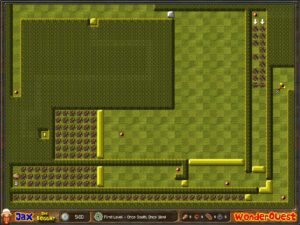Wonderquest: Orion’s End
It’s been a little while since my last Wonderquest update. This is partly (but only partly) because level 15 was something of a slog, with lots of puzzles based around grueling tactical trial-and-error rather than satisfying “Aha!” moments. And on top of that, it’s essentially two levels packed into one. Most levels have had some sort of finale, a single large-scale multi-room puzzle interposed between crossing the “level clear” gate (which opens when you’ve killed all the monsters) and the actual exit. Level 15 ends in a suite of twelve independent puzzles, giving each playable character a final bow, a much more satisfying ending than the level’s first half. The reward for each of the twelve is a “relic” that permanently erases one otherwise-impassible “cursed ground” tile. The level exit is guarded by only ten cursed grounds in series, so you have a little leeway, although a completist like myself will want all twelve relics to claim two optional “secrets”.
Relics are the one resource that stays with you between rooms (although not between levels), and they basically exist just for this endgame sequence. Previous levels had a single cursed ground you could clear just before the exit, providing a shortcut that let you go hunt for secrets without having to go through the finale a second time. DROD occasionally produces the same effect with a “room clear” gate, but using relics untethers the design from monster-slaying. And the level 15 ending suite does the same for puzzles in general, showing us how relics can give us difficult goals that don’t involve monsters at all. This is an idea I’d like to see explored more. I bet there are DROD holds based on it, although Wonderquest has more mechanics suited to supporting it.
One thing that I found peculiar as I was finishing up the “Master Orion” quest: A lot of the characters have special abilities listed that they never have an opportunity to exercise. In particular, several have a “high morale” bonus that improves their weapon when the party’s resources reach a certain threshold, which you could never reach. What’s this stuff for? By now, I’ve played enough of the followup quest, “Dreams”, to know the answer. It seems to be a solution to a design problem: By the end of “Master Orion”, the author has given us all the playable characters he intends us to have. But he still wants to keep giving us new abilities over the course of “Dreams”, because that’s how he designs puzzles.
 Comments(0)
Comments(0)